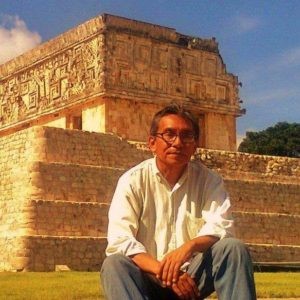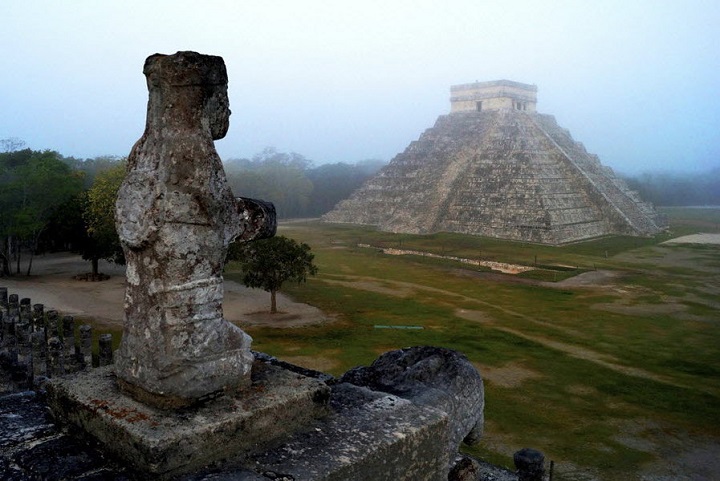In Yucatan, sitting at the door of his house, Don Juan Ek Tun watches how the sun gradually illuminates the church of his village, a 17th century construction. It is 6:30 am. Don Juan is 85 years old, and no longer works in the fields. His wife, Mrs. Jacinta Chablé Can, 83 years old, speaks to him from inside their home.
They speak Maya and have all the beliefs and customs that their respective fathers had and taught them. Now they work at home, and feed their backyard animals: chickens, turkeys, pigs.
The five children of don Juan and doña Jacinta, live in another village, one is a teacher, and the others are merchants. Three of doña Jacinta’s and don Juan’s grandchildren live abroad, two in the United States and one in Germany.
The Ek Chablé family and all their descendants have many things in common: they all speak Maya, including the grandchildren who live abroad, they all learned the customs and beliefs of their ancestors, they all love the land where they were born, even though some no longer live in the Yucatan, sometimes the grandchildren who are outside the country communicate with their grandparents through video calls. For don Juan and doña Jacinta, the new technology is no longer unknown.
In 2000 BC, one of the first human groups to settle in the mountains of Guatemala, began to differentiate itself more and more from the others, adopting its own characteristics and forming a new group that anthropologists, linguists and archaeologists have called proto-Maya. In later times, other subgroups of the proto-Maya group began to break away and move to other locations, such as the Yucatan peninsula, part of the current Mexican states of Chiapas and Tabasco; Belize; the rest of Guatemala and part of Honduras and El Salvador, thus giving rise to the Mayan linguistic family and forming the current Maya area.
Throughout this vast territory of Central America, these first Maya began to develop their culture, their social and political organization, as well as their magical thinking and their incipient architecture, some of these villages becoming true imposing cities, during this period called pre-classic.
It was until 300 A.D. when all the Maya area was occupied by those primitive villages, already converted into cities and then began the apogee of the Maya culture, reaching the levels of civilization, in the so-called classic stage.
It was 600 years of apogee of the Maya civilization, six centuries in which the knowledge acquired throughout the thousands of years back, had its splendor. The political and social organization, science, art, agriculture, commerce, shone greatly.
Here we must point out something important. Culture is not the same as civilization. Culture is the ensemble of all the ways of being and doing of human beings, and comprises both material and immaterial aspects. Civilization is the highest degree of development that a society or culture achieves. All human societies have culture, but not all reach, or have reached, the level of civilization.
In the 9th century, several adverse events in the Mayan area, such as: droughts, earthquakes in the seismic zones, hurricanes, deforestation, soil exhaustion, famine, diseases, and the lack of response from the ruling class to face, solve, those situations, gave rise to deep social discontent. The rulers and priests questioned their deities about all this, but the magic thinking did not give solutions to the problems and uprisings arose, true revolutions that destroyed many cities.
In one century, the IX A.D., the Mayan civilization was ruined, numerous cities were abandoned, the splendor stopped abruptly, new cities were not founded, the population lived in villages around the ruins of the ancient metropolis. This was the so-called Mayan collapse.
Pre-Columbian life continued in a period that is now called the decadent, or post-classical, period. But one hundred years later, in the 10th century AD, Chichen Itza stood on the Yucatan Peninsula as the last great Mayan city. However, in the 13th century this city also came to an end. The Mayan civilization had just collapsed, when in the sixteenth century, 1517, appeared in the Mayan area, in the Yucatan Peninsula arrived the first Spanish conquerors, and then began a new history of the Mayan people.
A history that reaches our days, and of which don Juan Ek and doña Jacinta Chablé together with their descendants are part of, and they show us how the Mayas did not disappear, how the Mayan culture continues alive in the modern Mayas, heirs of the ancient Mayas who built one of the most amazing civilizations of Ancient America.
For The Yucatan Times
Indalecio Cardeña Vázquez
Merida, Yucatan
February 14 2020
 Indalecio Cardeña Vázquez. – Anthropologist, researcher and writer.
Indalecio Cardeña Vázquez. – Anthropologist, researcher and writer.
He has collaborated with the “Unidad Yucatán de la Dirección de Culturas Populares”, Instituto Nacional Indigenista and was the director of the Pinacoteca “Juan Gamboa Guzmán” of the INAH. Among his anthropological works are the iconographic analysis of the colonial sacred art of the Yucatan Peninsula; the symbolisms in the facade of Conquistador Montejo’s house, in Mérida; the Mayan symbolism in the Yucatan Cathedral and the archaeoastronomy among the Mayans.
Professor Cardeña has written several books and articles since the mid 1980’s to this date.



